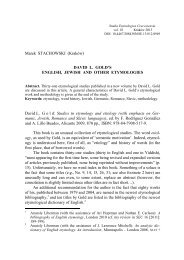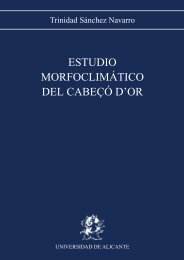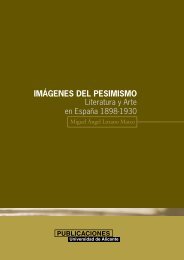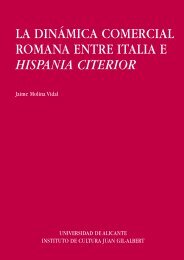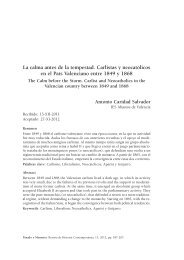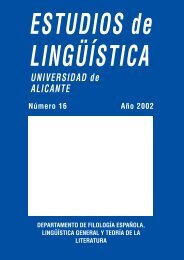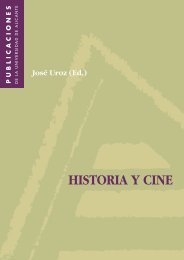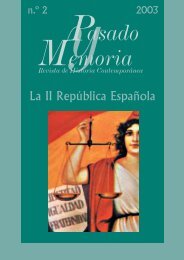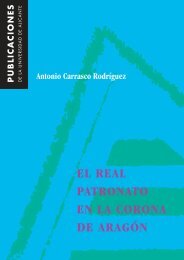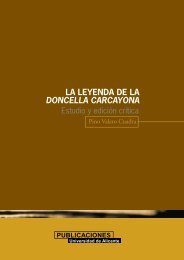English and Galician in the Middle Ages - Publicaciones ...
English and Galician in the Middle Ages - Publicaciones ...
English and Galician in the Middle Ages - Publicaciones ...
Create successful ePaper yourself
Turn your PDF publications into a flip-book with our unique Google optimized e-Paper software.
<strong>English</strong> <strong>and</strong> <strong>Galician</strong> <strong>in</strong> <strong>the</strong> <strong>Middle</strong> <strong>Ages</strong>:<br />
A Sociohistorical Survey<br />
Begoña Crespo García<br />
tact. In fact, <strong>the</strong>se social ‘contact groups’ may have spread<br />
bil<strong>in</strong>gualism among <strong>the</strong>ir members. As Claiborne (1990: 99)<br />
po<strong>in</strong>ts out:<br />
From <strong>the</strong> po<strong>in</strong>t of view of language, <strong>the</strong> most notable effect of <strong>the</strong><br />
Norman Conquest was to convert Engl<strong>and</strong>, almost overnight, <strong>in</strong>to<br />
a bil<strong>in</strong>gual country. The upper classes spoke French; before long<br />
<strong>the</strong>y were jo<strong>in</strong>ed by those of <strong>the</strong> <strong>English</strong> middle <strong>and</strong> lower classes<br />
who had regular deal<strong>in</strong>gs with <strong>the</strong>m: tradesmen, manor ‘foremen’<br />
<strong>and</strong> <strong>the</strong> like. French was always essential to anyone with ambitions<br />
of ris<strong>in</strong>g <strong>in</strong> <strong>the</strong> social scale. The rest of <strong>the</strong> population cont<strong>in</strong>ued<br />
speak<strong>in</strong>g <strong>English</strong> at home <strong>and</strong> among <strong>the</strong>mselves, though many of<br />
<strong>the</strong>m doubtless learned to underst<strong>and</strong> French if not speak it.<br />
The second factor which guaranteed <strong>the</strong> survival of <strong>English</strong> after<br />
<strong>the</strong> conquest is related to <strong>the</strong> existence of literature written<br />
<strong>in</strong> <strong>English</strong>. The use of <strong>the</strong> vernacular for writ<strong>in</strong>gs of a historical,<br />
homiletic or didactic character cont<strong>in</strong>ued after <strong>the</strong> com<strong>in</strong>g<br />
of <strong>the</strong> Normans. <strong>Middle</strong> <strong>English</strong> works such as Layamon’s<br />
Brut, The Owl <strong>and</strong> <strong>the</strong> Night<strong>in</strong>gale, Sir Gawa<strong>in</strong> <strong>and</strong> <strong>the</strong> Green<br />
Knight <strong>and</strong> Ancrene Riwle prove <strong>the</strong> existence of an audience<br />
who could be addressed <strong>in</strong> <strong>English</strong> at <strong>the</strong> end of <strong>the</strong> 12 th century.<br />
Moreover, some Anglo-Lat<strong>in</strong> historians such as William<br />
of Malmesbury <strong>and</strong> Henry of Hunt<strong>in</strong>gdon narrate stories <strong>in</strong><br />
<strong>English</strong> about Saxon k<strong>in</strong>gs that <strong>the</strong>y claim to have heard from<br />
<strong>the</strong> peasantry. These works prove that <strong>English</strong> was also used<br />
CONTENTS<br />
11



